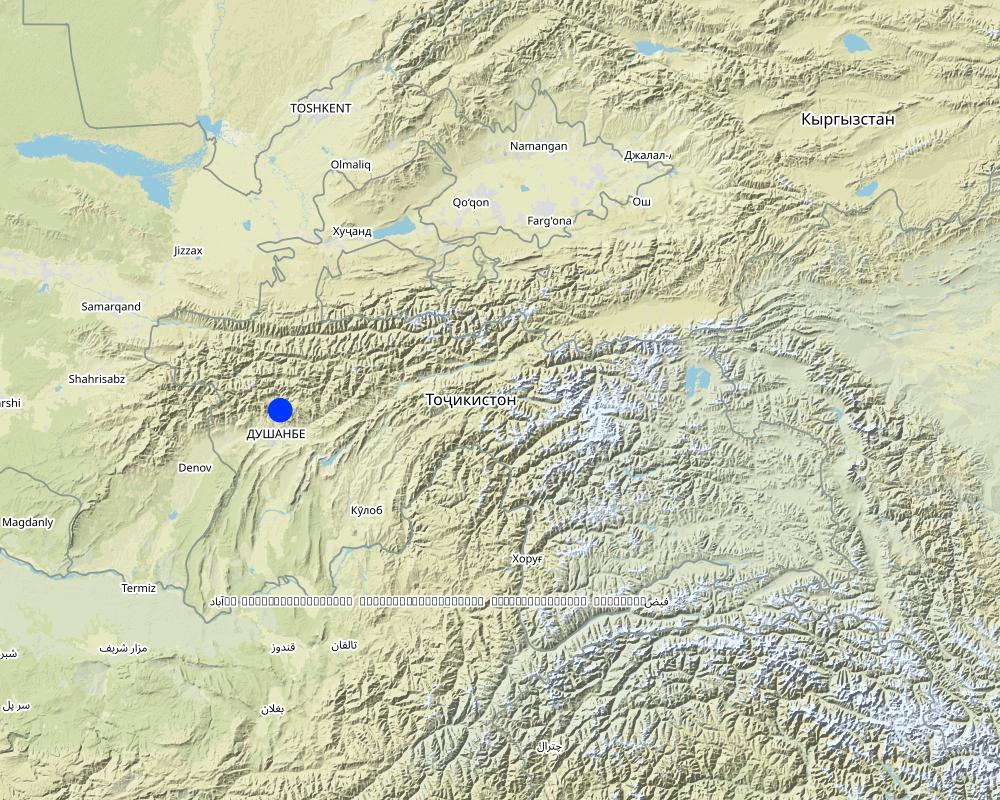Joint Land User Initiative [塔吉克斯坦]
- 创建:
- 更新:
- 编制者: Erik Bühlmann
- 编辑者: –
- 审查者: David Streiff, Alexandra Gavilano, Joana Eichenberger
approaches_2642 - 塔吉克斯坦
查看章节
全部展开 全部收起1. 一般信息
1.2 参与方法评估和文件编制的资源人员和机构的联系方式
有助于对方法进行记录/评估的项目名称(如相关)
Pilot Program for Climate Resilience, Tajikistan (WB / PPCR)有助于对方法进行记录/评估的机构名称(如相关)
NCCR North-South (NCCR North-South) - 吉尔吉斯斯坦1.3 关于使用通过WOCAT记录的数据的条件
编制者和关键资源人员接受有关使用通过WOCAT记录数据的条件。:
是
2. SLM方法的描述
2.1 该方法的简要说明
Joint initiative of neighbouring land users to prevent soil erosion in steep sloping cropland.
2.2 该方法的详细说明
该方法的详细说明:
Aims / objectives: There was an agreement between neighbouring land users, on a measure they could implement jointly to prevent soil erosion in steep sloping cropland, and to prevent disputes between them about inappropriate land use and land management practices. The decision was made that a grass strip should be left uncultivated on the field boundary between upslope and downslope land users when the pasture was turned into cropland. Farmers decided to contribute equally to the establishment of the technology.
2.5 采用该方法的国家/地区/地点
国家:
塔吉克斯坦
区域/州/省:
RRS
Map
×2.7 方法的类型
- 最近的本地倡议/创新
2.8 该方法的主要目的/目标
The Approach focused on SLM only
To reduce soil erosion and the downslope washing of seeds, and also to help avoid disputes between neighbouring land users about land use and land management practices.
The SLM Approach addressed the following problems: Land losses in connection with soil and water conservation are too costly to be bourne by a single land user alone.
2.9 推动或妨碍实施本办法所适用的技术的条件
法律框架(土地使用权、土地和水使用权)
- 阻碍
The existing land ownership, land use rights / water rights moderately hindered the approach implementation Poor farmers rent cropland from the state. The area which is occupied by the grass strip is classified as cropland which is much more expensive than renting of grazing land. Farmers may be reluctant to implement grass strips if they have to rent the area at the cropland rates.
其他
- 阻碍
Lack of land available for implementation of grass strip.
Treatment through the SLM Approach: Sharing of land losses.
3. 相关利益相关者的参与和角色
3.1 该方法涉及的利益相关者及其职责
- 当地土地使用者/当地社区
Only men participated in the approach.
3.2 当地土地使用者/当地社区参与该方法的不同阶段
| 当地土地使用者/当地社区的参与 | 指定参与人员并描述活动 | |
|---|---|---|
| 启动/动机 | 自我动员 | |
| 计划 | 自我动员 | upslope and downslope land users decided together about the location and the size of the grass strip |
| 实施 | 自我动员 | |
| 监测/评估 | 无 | |
| Research | 无 |
3.4 有关SLM技术选择的决策
具体说明谁有权决定选择要实施的技术:
- 仅限土地使用者(自主)
解释:
experimental land user initiative
Decisions on the method of implementing the SLM Technology were made by by land users* alone (self-initiative / bottom-up)
4. 技术支持、能力建设和知识管理
4.1 能力建设/培训
是否为土地使用者/其他利益相关者提供培训?:
否
4.2 咨询服务
土地使用者有权使用咨询服务吗?:
是
指明是否提供了咨询服务:
- 在土地使用者的土地上
说明/注释:
Name of method used for advisory service: informal land user extension
4.3 机构强化(组织发展)
是否通过这种方法建立或加强了机构?:
- 否
4.4 监测和评估
监测和评估是该方法的一部分吗?:
是
注释:
technical aspects were ad hoc monitored by 0 through observations; indicators: None
economic / production aspects were ad hoc monitored by 0 through measurements; indicators: None
area treated aspects were ad hoc monitored by 0 through observations; indicators: None
There were no changes in the Approach as a result of monitoring and evaluation: None
4.5 研究
研究是该方法的一部分吗?
否
5. 融资和外部物质支持
5.2 为土地使用者提供财政/物质支援
土地使用者是否获得实施该技术的财政/物质支持?:
否
5.3 对特定投入的补贴(包括劳动力)
如果土地使用者的劳动力是一项重要的投入,那么是不是:
- 自愿
注释:
joint action of neighbouring land users
5.4 信用
是否根据SLM活动的方法给予信用值?:
否
5.5 其它激励或手段
是否有其他激励措施或工具用于促进SLM技术的实施?:
否
6. 影响分析和结论性陈述
6.1 方法的影响
该方法是否帮助土地使用者实施和维护SLM技术?:
- 否
- 是,很少
- 是,中等
- 是,支持力度很大
Through sharing of the land lost to the strip, a larger area can be used for the implementation of the SWC technology, which ultimately enhances its effectiveness in reducing soil erosion
该方法是否有助于社会和经济弱势群体?:
- 否
- 是,很少
- 是,中等
- 是,支持力度很大
该方法是否改善了阻碍SLM技术实施的土地使用权/用户权问题?:
- 否
- 是,很少
- 是,中等
- 是,支持力度很大
The problem is unlikely to be overcome in the near future. As long as land is state owned, farmers will remain reluctand to sacrifice land for SWC purposes.
Did other land users / projects adopt the Approach?
- 否
- 是,很少
- 是,中等
- 是,支持力度很大
According to the farmers involved, there is no reason why other farmers could not adopt their approach since they consider it to be a big advantage. However, there may be a general reluctance among other land users to sacrifice valuable cropland for implementation of a grass strip.
Did the Approach lead to improved livelihoods / human well-being?
- 否
- 是,很少
- 是,中等
- 是,支持力度很大
Did the Approach help to alleviate poverty?
- 否
- 是,很少
- 是,中等
- 是,支持力度很大
6.2 土地使用者实施SLM的主要动机
- 增加生产
- 声望、社会压力/社会凝聚
- 环境意识
6.3 方法活动的可持续性
土地使用者能否维持通过该方法实施的措施(无外部支持的情况下)?:
- 是
6.4 该方法的长处/优点
| 土地使用者眼中的长处/优势/机会 |
|---|
| Approach helps reduce conflicts between land users. |
| The land occupied by the SWC technology is shared between land users. |
| Strong ownership of the approach. |
| 编制者或其他关键资源人员认为的长处/优势/机会 |
|---|
| Joint initiative helps to avoid possible disputes between neighbouring land users. |
| No inputs required. |
| Land losses can be shared between farmers. |
6.5 该方法的弱点/缺点以及克服它们的方法
| 土地使用者认为的弱点/缺点/风险 | 如何克服它们? |
|---|---|
| none |
| 编制者或其他关键资源人员认为的弱点/缺点/风险 | 如何克服它们? |
|---|---|
| Poor spreading of approach. | |
| Poor collaboration and institutional linking. | Promote interaction at community level. |
链接和模块
全部展开 全部收起链接
无链接
模块
无模块


